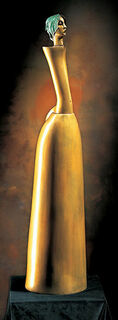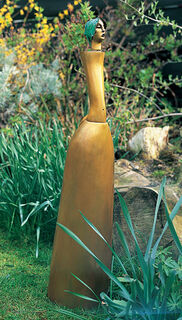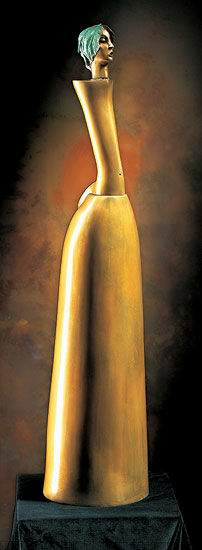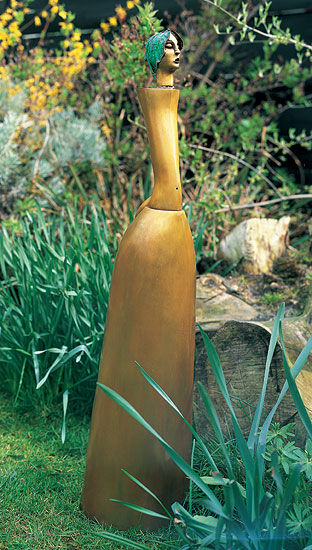Sculpture "The Beautiful Gardener", bronze
Sculpture "The Beautiful Gardener", bronze
Quick info
limited, 48 copies | numbered | signed | bronze | patinated | polished | height 94 cm | weight approx. 17.5 kg
Detailed description
Sculpture "The Beautiful Gardener", bronze
The formal clarity of the beautiful gardener enhances her presence. Through the volume of the sculpture and its smooth surface, free of all accessories, we recognise the beauty of the material. The shimmering golden bronze catches the light of the surroundings and reflects it in ever new modulations. Plasticity is not only the property of a body but also the play of light. The finely modelled face of the figure takes us back to interpretations of the content. It has an indefinite expression: concentration, desire, renunciation, a look inwards - these are possibilities to project our own dreams onto the work. And the cap of green vine leaves, to which the sculpture owes its name, leads us back from the dream world to reality.
Sculpture in fine bronze, cast using the Lost-Wax-Process. Patinated, partly polished. Edition of 48 copies, numbered and signed. Height 94 cm, weight approx. 17.5 kg. Catalogue raisonné no. 312.
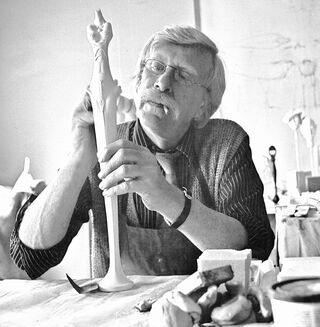
About Paul Wunderlich
1927-2010
Like no other artist of our time, Paul Wunderlich was one of the most influential style-forming artists of the modern age. Only in 1960, the Hamburg prosecutor seized his works for "indecent". Three years later, the relativley young Paul Wunderlich was hired as a professor at the University of Fine Arts. Numerous awards such as the Edwin Scharff Prize honours at the biennial arts exhibition in Ireland, Taiwan and Bulgaria made Wunderlich internationally famous. He was the only German artist to be admitted to the Paris "Académie des Beaux-Arts". Paul Wunderlich lived and worked both in Hamburg and France until his death in June 2010.
Born in 1927 in Eberswalde near Berlin, the painter and sculptor learned to draw at the Palace School of Art in the Orangery of Eutin Castle. Immediately after World War II, he visited the Hamburg Academy of Fine Arts to study graphic arts. After completing his studies, he remained there working as a drawing teacher and in 1963 became a professor.
In the early 1950s, he met Emil Nolde and Oskar Kokoschka. Under their guidance he printed reproductions of their works. He developed a very idiosyncratic style in which manneristic and surrealistic, as well as elements of Art Nouveau and Art Deco, meet. He initially drew his themes inspired by German history, for example the cycle of lithographs "20 July 1944". Later, erotic and sexual motifs became more significant which he treated with delicacy and also a hint of morbidity. In 1960, one such cycle of lithographs was seized by the Hamburg prosecutor for indecent depictions.
In the 1960s he began to work based on photographs by Karin Székessy. After he resigned from his professorship in 1968, he made several study trips to New York and Switzerland. From then on, he also worked on sculpturally aestheticised everyday objects that were parallel with the subtly crafted imagery of his lithographs.
"His works are recognised, appreciated and also bought by a broad public all over the world," writes Paul Wunderlich's biographer Jens Christian Jensen. "Art connoisseurs agree: Paul Wunderlich is the leading master of fantastic realism and one of the very few style-forming artists of our time."
"Out of all the truisms that are spread about his life's work, only one fact is for sure: the realisation that Paul Wunderlich became the unsurpassed master of lithography after Picasso." (Prof. Heinz Spielmann)
"If one searches for the greatest master in the art of lithography in all its possibilities, there is no doubt that Paul Wunderlich deserves all credits." (Carl Vogel)
An alloy of copper with other metals (especially with tin) used since ancient times.
When casting bronze, the artist usually applies the lost-wax technique which is dating back more than 5000 years. It's the best, but also the most complex method of producing sculptures.
First, the artist forms a model of his sculpture. It is embedded in a liquid silicone rubber mass. Once the material has solidified, the model is cut out. The liquid wax is poured into the negative mould. After cooling down, the wax cast is removed from the mould, provided with sprues and dipped into ceramic mass. The ceramic mass is hardened in a kiln, whereby the wax flows out (lost mould).
Now we finally have the negative form, into which the 1400° C hot molten bronze is poured. After the bronze had cooled down, the ceramic shell is broken off and the sculpture is revealed.
Now the sprues are removed, the surfaces are polished, patinated and numbered by the artist himself or, to his specifications, by a specialist. Thus, each casting becomes an original work.
For lower-quality bronze castings, the sand casting method is often used which, however, does not achieve the results of a more complex lost-wax technique in terms of surface characteristics and quality.
Term for an art object (sculpture, installation), which is produced in multiple copies in a limited and numbered edition according to the artist‘s will.
Artist's multiples have been called the most accessible and affordable art on the market.
A plastic work of sculptural art made of wood, stone, ivory, bronze or other metals.
While sculptures from wood, ivory or stone are made directly from the block of material, in bronze casting a working model is prepared at first. Usually, it is made of clay or other easily mouldable materials.
The prime time of sculpture after the Greek and Roman antiquity was the Renaissance. Impressionism gave a new impulse to the sculptural arts. Contemporary artists such as Jorg Immendorf, Andora, and Markus Lupertz also enriched sculptures with outstanding works.

